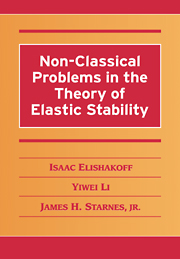Book contents
- Frontmatter
- Contents
- Preface: Why Still Another Book on Stability?
- 1 Mode Localization in Buckling of Structures
- 2 Deterministic Problems of Shells with Variable Thickness
- 3 Stochastic Buckling of Structures: Monte Carlo Method
- 4 Stochastic Buckling of Structures: Analytical and Numerical Non-Monte Carlo Techniques
- 5 Anti-Optimization in Buckling of Structures
- 6 Application of the Godunov-Conte Shooting Method to Buckling Analysis
- 7 Application of Computerized Symbolic Algebra in Buckling Analysis
- Bibliography
- Author Index
- Subject Index
Preface: Why Still Another Book on Stability?
Published online by Cambridge University Press: 06 January 2010
- Frontmatter
- Contents
- Preface: Why Still Another Book on Stability?
- 1 Mode Localization in Buckling of Structures
- 2 Deterministic Problems of Shells with Variable Thickness
- 3 Stochastic Buckling of Structures: Monte Carlo Method
- 4 Stochastic Buckling of Structures: Analytical and Numerical Non-Monte Carlo Techniques
- 5 Anti-Optimization in Buckling of Structures
- 6 Application of the Godunov-Conte Shooting Method to Buckling Analysis
- 7 Application of Computerized Symbolic Algebra in Buckling Analysis
- Bibliography
- Author Index
- Subject Index
Summary
The preface is the most important part of the book. Even reviewers read a preface.
Philip GuedallaThere are at present numerous books available on the theory of stability and its applications to structures. One author even remarked sarcastically that if they were put in a single bookcase, it would buckle under their weight. We do not complain that “…of the making of many books there is no end” (Ecclesiastes 12:12), rather we ask a natural question: Is there a legitimate place for a new book in this field?
The answer to this question is affirmative, if a book has its unique, distinct characteristics. We have chosen to deal with non-classical problems. To the best of our knowledge, none of the subjects, touched upon in this monograph, have been discussed exclusively in the existing books on buckling analysis. Thus we feel that this book will not be just another newbook on buckling. Indeed, most existing books may be classified as belonging to one of the following two categories: textbooks which often look very much alike, maybe not without reason, since the subject is the same and monographs which have an encyclopedic nature, trying to comprise an uncomprisable to cover all or nearly all pertinent topics. This latter task of listing all the results (even only those of major importance) appears to be impossible indeed.
The purpose of this book is to present two competing theories, which incorporate ever-present uncertainty in the stability applications of the real world.
- Type
- Chapter
- Information
- Non-Classical Problems in the Theory of Elastic Stability , pp. ix - xviPublisher: Cambridge University PressPrint publication year: 2001



